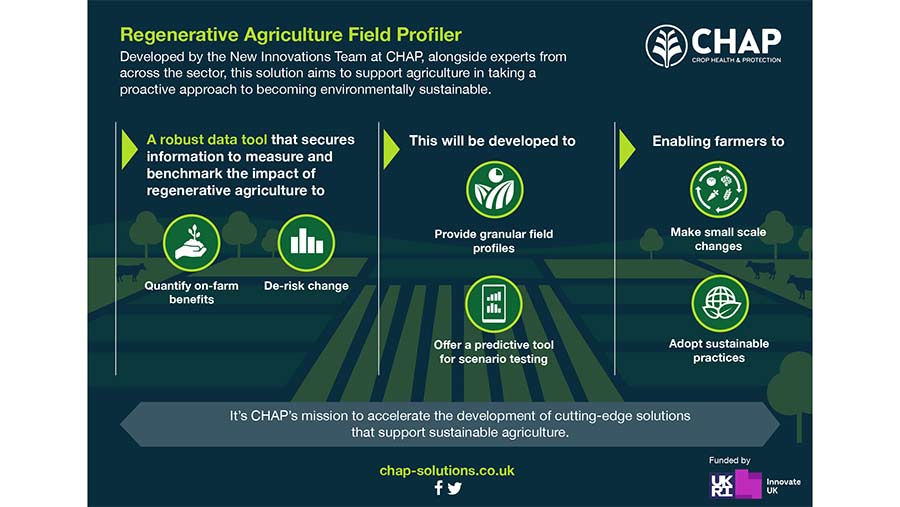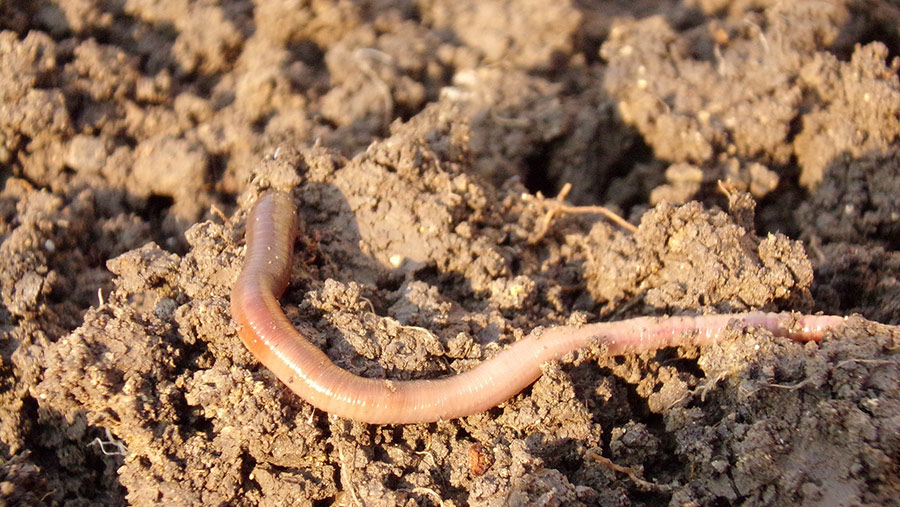Advertiser content
De-risking regenerative agriculture decision-making

Regenerative Agriculture Field Profiler Infographic © CHAP
A proposed solution that aims to help farmers de-risk the adoption of regenerative agriculture practices has been developed by Agri-Tech Innovation Centre, Crop Health and Protection (CHAP).
The solution was devised as part of an industry-informed business case, which involved conducting qualitative research, with a view to understanding the perceived barriers to adoption of regen ag, from a farmer perspective.
Dr Harry Langford, Innovation Network Lead for CHAP, helps to bring together skilled practitioners and technical specialists to glean such intelligence.
Dr Langford said: “Given its flourishing popularity, it soon became apparent that CHAP needed to explore regenerative agriculture, to try to get to the bottom of why something with so much promise isn’t achieving widespread industry adoption.
“We wanted to know what the perceived barriers are, from a farmers’ perspective, before devising a potential solution. Although these are presented as barriers, they are in fact opportunities for change and improvement.”
Risk, evidence and reward
The first barrier was identified as the real and perceived risk from undertaking new practices with unknown and less predictable outcomes.
CHAP’s research suggested that key to driving the sector forward is reducing the risks of regen ag, or at least adjusting what is perceived.
“Perceived risk also links to evidence – a current lack of robust data to support current claims and championed benefits associated with regen ag,” continued Dr Langford. “On-farm evidence is something that we can’t get enough of as an industry, so working to measure and record data will be important.
“Our stakeholders identified reward, or lack of, as another perceived barrier. With few incentives or basic recognition for regen-produced food, this could be viewed as off-putting. Consumer perception could play a part here, boosting potential markets for produce such as legumes, or drawing attention to products with sustainable credentials.”

Harry Langford © CHAP
Integrated, systems-based approach
For many of the stakeholders involved, questions arose around how regen ag differs from other approaches such as conservation agriculture and integrated farm management (IFM). This confusion may be seen as a barrier to entry, despite strong parallels between the systems.
Dr Langford added: “Although diversity is often what makes farming interesting and enjoyable, it also means a one-size-fits-all approach isn’t possible.
With vast heterogeneity of soil systems and farm management plans, understanding how regen ag can be adapted at individual farm or field level will help.
“Another question raised, was how to implement a successful transition period, given regen ag is based on improving the biological status and health of soil, which is not an over-night fix.
“Creating digestible time-lines with achievement milestones could improve farmers’ commitment to the cause and support their regen ag journey.”

© CHAP
Change in mindset
Critical in the findings was the notion that change is difficult in any sector or business. Stakeholders discussed that opportunity lies in overcoming resistance to change. Alongside this, increasing the appetite for risk was also identified as important, because much of regen ag remains unknown.
“But, tools are available to help overcome all of the above challenges, and these are often in the shape of novel agri-tech solutions,” said Dr Langford. “As well as understanding the ‘problem’, CHAP also strives to devise innovative solutions.
“In this case, it was identified as the Regenerative Agriculture Field Profiler – a data modelling tool that measures and benchmarks the impact of regen ag, helping farmers to quantify the on-farm benefits and de-risk change.
As it develops, this will be used to produce granular field profiles specific to different soil types and topographies, with the ultimate goal of creating a predictive tool that offers scenario testing and simulation.”
Although just a concept, CHAP is now looking to build an industry consortium and seek grant funding to help make the solution a reality. Those interested in being involved are encouraged to contact CHAP – enquiries@chap-solutions.co.uk or visit chap-solutions.co.uk to find out more.
Provided by
CHAP is one of the four UK Agri-Tech Centres of Innovation. We bring together scientists, farmers, advisors, and pioneers to advance crop productivity and yield in the UK and beyond.
